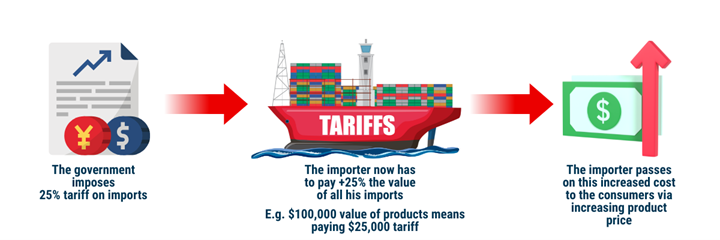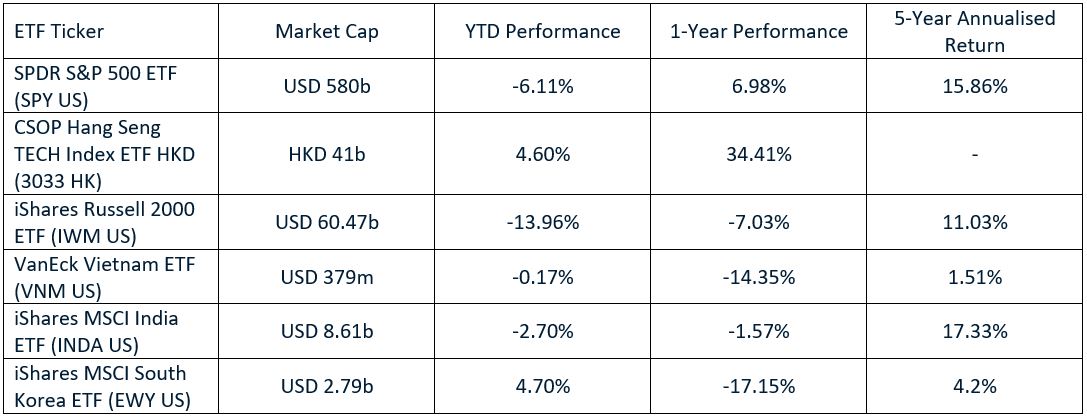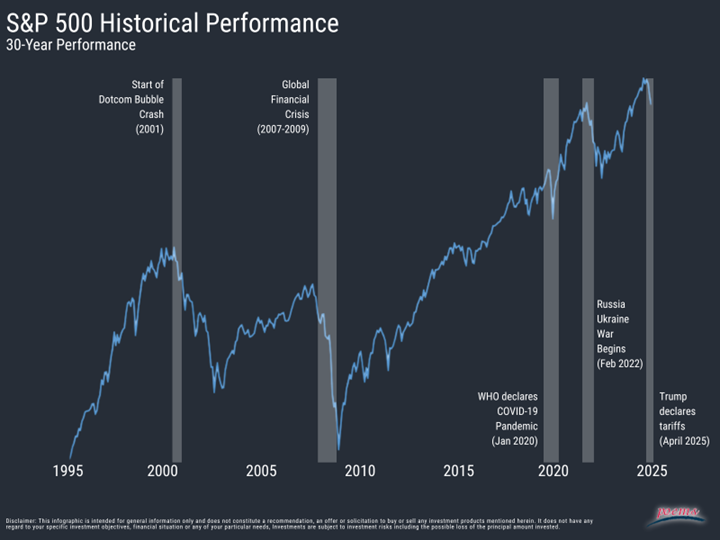Tariffs and Their Impact on Global Economies April 21, 2025

Key Takeaways
Tariffs are taxes on imports used to raise government revenue, protect local industries, and exert political pressure. While they can benefit domestic producers, they often lead to higher consumer prices, inflation, and retaliatory actions. In April 2025, the US imposed sweeping tariffs, 125% on Chinese goods, which prompted an 84% response from China as of 10 April 2025, escalating trade tensions and market volatility. This could significantly impact smartphone prices as many devices are manufactured or assembled in China. Some speculate that the price of an iPhone might hit US$3,000. This is unlikely to be the first, or the last instance of such tariffs in this ongoing trade conflict. Investors can navigate this by diversifying across regions and sectors, focusing on long-term goals, and staying informed on global trade shifts.
What are Tariffs?

To put it simply, tariffs are taxes that are imposed by a government on imported goods. Calculated as a percentage of the good’s value, they are collected by the customs authorities, from the importer, at the point of entry into the imposing country. Governments impose tariffs to generate revenue, protect domestic industries from foreign competition, and as often seen nowadays, to create political leverage.
Why Governments Impose Tariffs
There are several key reasons governments choose to impose tariffs:
Revenue generation: Tariffs can be a significant source of income for governments, especially for countries with limited alternative forms of taxation.
Protecting domestic industries: By making imported goods more expensive, tariffs can encourage local consumers to buy locally produced products, which in turn supports domestic businesses and preserves jobs.
Political strategy: As seen frequently in recent events, tariffs can be used to exert pressure on other nations and trade partners to change unfavourable trade practices or policies, by simply depriving them of trade volume.
Impact on the Imposing Country
While tariffs can offer the benefits as mentioned above, they must be implemented carefully without potentially causing serious drawbacks in the imposing country.
Increased consumer prices: The duties on imported goods often lead to soaring prices, which inevitably negatively impacts the consumers as the businesses pass on the additional costs to them. And the cost is not always proportional to the tariff, which means a 10% tariff may increase prices more (or less) than 10%, depending on market dynamics and supply chains.
Inflationary pressures: Widespread tariffs can potentially contribute to overall inflation. As prices rise across multiple sectors, often uncontrollably, the general cost of living increases, putting pressure on household spending and the overall economy.
Retaliation risks: Targeted countries may not just accept the tariffs imposed on them; they may respond with their own tariffs, as seen most recently with the retaliatory tariffs China imposed on the US, and the barring of rare earth trade with them. Such measures can directly affect exporters and risk triggering a full-scale trade war—an outcome increasingly mirrored in current global events.
Impact on the Targeted Country
When a country is targeted by tariffs, the following economic consequences are almost inevitable:
Reduced competitiveness: Tariffs make the targeted country’s goods expensive in the foreign markets, often leading to decreased demand and sales, which will directly affect their export revenue and may also lead to oversupply, forcing them to lower prices.
Economic slowdown: Some countries rely very heavily on global trade, such as China, which is the world’s largest exporter of goods. About 20% of their GDP consists of exports of goods and services. Heavy tariffs aimed at such countries can therefore pose a significant threat to their economic stability.
Trade diversion: To avoid tariffs, exporters may seek alternative markets, leading to shifts in global trade patterns. This is a crucial development for investors to monitor, as it could result in unexpected growth opportunities in certain regions and downturns in others.
How do tariffs work?
To help visualise how tariffs work, imagine the following scenario:
A US citizen is planning to buy a car and is torn between two choices. The first is a Japanese-made car, priced at US$50,000. The second is a locally manufactured car of equal quality, priced at US$60,000. Initially, the buyer leans towards the Japanese car, as it offers the same quality at a lower price.
However, overnight, a 40% tariff was imposed on imported cars, forcing the dealership to raise the price of the Japanese car to US$70,000. Suddenly, the local car becomes the more attractive option based purely on price, and the buyer opts for it. The tariff has effectively shifted purchasing behaviour in favour of domestic products, without requiring any improvements or changes to the local offering.
As a result, sales of Japanese cars in the US decline, forcing Japanese manufacturers to consider lowering their prices or redirecting their exports elsewhere. Over time, the effects spread: that US$4 cup of tea from Japan now costs US$5.50, and that new kitchen appliance from Japan goes up by 20%. Gradually, the consumer starts switching to locally produced goods, and Japanese products become less visible on shelves as manufacturers divert supply to other markets.
This is just one example of how tariffs can influence consumer choices, business outcomes, and broader trade dynamics during tariff-induced trade conflicts.
Recent Developments in Trade Policy
In early April 2025, the US administration implemented extensive tariffs on many countries including a baseline tariff on imports and a substantial 104% tariff on Chinese goods. These measures of course resulted in significant market volatility; there were wide swings of more than 5% following a temporary pause on some tariffs, and a significant market downturn in March and April.
However, the heightened tariffs on Chinese imports have exacerbated the trade tensions between the two superpowers and also prompted a retaliation from China, which imposed an 84% levy on the US. These recent tariff hikes have led to increased prices for imported goods, which directly affects both consumers and investors.
Strategies for Investors
In light of the recent developments in the trade war and tariff-induced market turmoil, investors can consider the following approaches to this market:
Diversification: Spreading your investments across various sectors and regions minimise the risks associated with country-specific tariffs, and can mitigate some of the impact that large market shifts can have on your portfolio. Investors can also consider using ETFs which offer investors a way to diversify their portfolio and gain exposure to multiple companies with a single trade such as:
 Data is valid as of 10 April 2025
Data is valid as of 10 April 2025
Maintaining a Long-Term Investment Perspective: Keeping a long-term investment horizon can weather short-term market volatilities, simply put, the time in market may be more effective than timing the market. Staying the course and focusing on long-term financial goals will weather the storm.
The world has faced many large financial crises but understanding and navigating these challenges remain key. For instance, the S&P 500 has navigated a range of major global events, including the US–China trade war, the Russia–Ukraine conflict, and the COVID-19 pandemic, and still managed to deliver a 171.4% return over the past 10 years.

In times of turbulence, it is easy to react emotionally, however, historically, investors who maintain a long-term perspective tend to outperform those who attempt to time the market. The market moves in cycles and temporary drawdowns are part of the challenge and journey to accumulating wealth long-term.
Referring back to the S&P 500 example from earlier, investors who stayed and remained focused on long-term goals were ultimately rewarded. Setting clear investment objectives and building your portfolio around those targets helps ensure consistency through all market conditions.
Looking beyond the headlines and focusing on fundamentals and trends: Short-term market reactions are often driven by sentiment and speculation, but long-term performance is supported by fundamentals such as earnings growth, company innovations, demographic trends and overall company productivity. Identifying themes in the market, such as AI more recently, clean energy or further digital transformation could make the difference for long-term growth. Consider building exposure to sectors and companies that are positioned to benefit from megatrends or new innovations over the next 10 to 20 years.
Rebalance your portfolio regularly: Market movements can cause portfolios to drift over time, and rebalancing your portfolio can help realign it with your targeted asset allocation, and control your exposure to certain sectors or regions.
Avoid overtrading, just stay informed: Stay on top of the market and be informed, but do not overreact to every news event or market movement, this can hurt your long-term performance. It is best to trust your trading plan and research, and avoid unnecessary trades that may potentially build up fees or paper losses, or trigger an emotional response resulting in poor decision making.
Conclusion
It is crucial for investors to understand the implications of tariffs in order to make well-informed investment decisions. While tariffs can introduce market volatility, a well-diversified investment strategy that focuses on long-term financial objectives can help you navigate these challenges effectively. Staying invested and maintaining a long-term perspective often outweighs the benefits of impulse reactions to short-term market fluctuations. History has shown that such challenges are not new — they have occurred before and will likely happen again. What matters is how we respond. By staying the course and avoiding knee-jerk reactions, investors can position themselves to benefit from market recovery and long-term growth. Keep a close eye on developments from US President Donald Trump and ongoing surrounding the US–China trade war, as these will continue to shape global markets in the near term.
Appendix:
- [1]https://wits.worldbank.org/countryprofile/en/chn#:~:text=China%20All%20Products%20Exports%20and%20Imports&text=China%20services%20export%20is%20368%2C952%2C755%2C652.88,percentage%20of%20GDP%20is%2017.47%25
- [2] https://www.pbs.org/newshour/economy/5-things-to-know-about-tariffs-and-how-they-work
- [3] https://topforeignstocks.com/2023/02/03/growth-of-sp-500-thru-crisis-and-events-from-1970-to-2022-chart/
- [4] https://www.investopedia.com/news/what-are-tariffs-and-how-do-they-affect-you/
- [5] https://www.cbsnews.com/news/which-products-most-affected-tariffs
- [6] https://news.darden.virginia.edu/2025/02/04/qa-what-are-tariffs-and-how-will-they-affect-us/
- [7] https://www.businessinsider.com/trump-tariffs-are-here-2025-4
- [8] https://www.channelnewsasia.com/east-asia/china-tariffs-us-goods-84-donald-trump-trade-war-505467
Disclaimer
These commentaries are intended for general circulation and do not have regard to the specific investment objectives, financial situation and particular needs of any person. Accordingly, no warranty whatsoever is given and no liability whatsoever is accepted for any loss arising whether directly or indirectly as a result of any person acting based on this information. You should seek advice from a financial adviser regarding the suitability of any investment product(s) mentioned herein, taking into account your specific investment objectives, financial situation or particular needs, before making a commitment to invest in such products.
Opinions expressed in these commentaries are subject to change without notice. Investments are subject to investment risks including the possible loss of the principal amount invested. The value of units in any fund and the income from them may fall as well as rise. Past performance figures as well as any projection or forecast used in these commentaries are not necessarily indicative of future or likely performance.
Phillip Securities Pte Ltd (PSPL), its directors, connected persons or employees may from time to time have an interest in the financial instruments mentioned in these commentaries.
The information contained in these commentaries has been obtained from public sources which PSPL has no reason to believe are unreliable and any analysis, forecasts, projections, expectations and opinions (collectively the “Research”) contained in these commentaries are based on such information and are expressions of belief only. PSPL has not verified this information and no representation or warranty, express or implied, is made that such information or Research is accurate, complete or verified or should be relied upon as such. Any such information or Research contained in these commentaries are subject to change, and PSPL shall not have any responsibility to maintain the information or Research made available or to supply any corrections, updates or releases in connection therewith. In no event will PSPL be liable for any special, indirect, incidental or consequential damages which may be incurred from the use of the information or Research made available, even if it has been advised of the possibility of such damages. The companies and their employees mentioned in these commentaries cannot be held liable for any errors, inaccuracies and/or omissions howsoever caused. Any opinion or advice herein is made on a general basis and is subject to change without notice. The information provided in these commentaries may contain optimistic statements regarding future events or future financial performance of countries, markets or companies. You must make your own financial assessment of the relevance, accuracy and adequacy of the information provided in these commentaries.
Views and any strategies described in these commentaries may not be suitable for all investors. Opinions expressed herein may differ from the opinions expressed by other units of PSPL or its connected persons and associates. Any reference to or discussion of investment products or commodities in these commentaries is purely for illustrative purposes only and must not be construed as a recommendation, an offer or solicitation for the subscription, purchase or sale of the investment products or commodities mentioned.
This advertisement has not been reviewed by the Monetary Authority of Singapore.
About the author
Global Markets Desk (Asia Market)
The Global Markets Desk Asia Market Dealing team specializes in managing Asia Markets, covering key regions like Greater China, Malaysia, Japan, Thailand, and others. In addition to executing client orders, they also provide educational content through market journals and webinars, offering insights into macroeconomics, stock picks, and technical analyses for the Asia market landscape.

 SATS Builds Global Platform to Navigate Market Volatility
SATS Builds Global Platform to Navigate Market Volatility  Yoma Strategic Holdings Delivers Strong Property Performance in 1H26
Yoma Strategic Holdings Delivers Strong Property Performance in 1H26  Buffer ETFs — What Are They and How Do They Work?
Buffer ETFs — What Are They and How Do They Work?  Oracle Corporation Raises FY27 Revenue Guidance by $4 Billion Amid Strong Cloud Growth
Oracle Corporation Raises FY27 Revenue Guidance by $4 Billion Amid Strong Cloud Growth 




